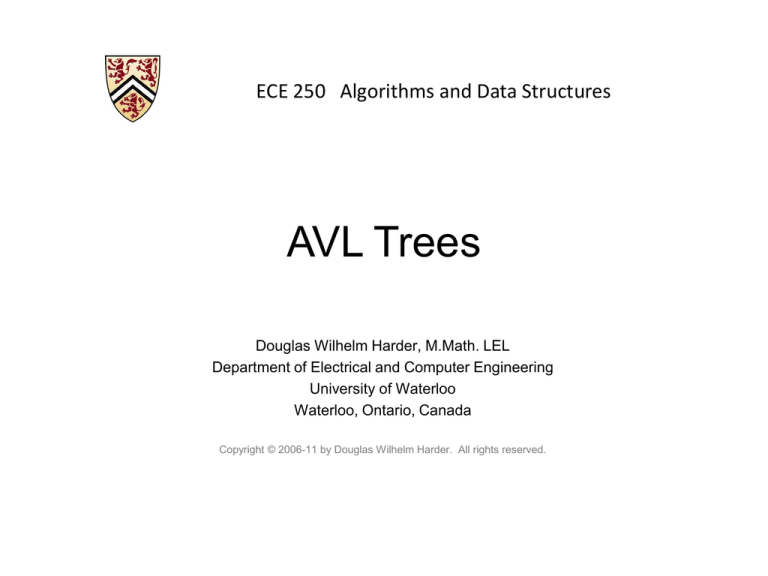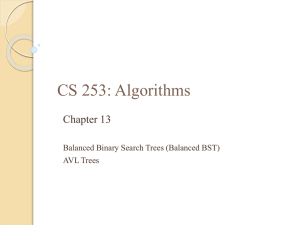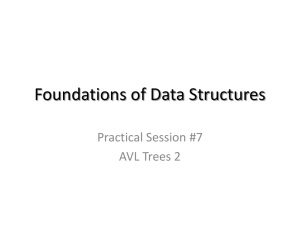
ECE 250 Algorithms and Data Structures
AVL Trees
Douglas Wilhelm Harder, M.Math. LEL
Department of Electrical and Computer Engineering
University of Waterloo
Waterloo, Ontario, Canada
Copyright © 2006-11 by Douglas Wilhelm Harder. All rights reserved.
AVL Trees
Outline
Background
Define balance
Maintaining balance within a tree
– AVL trees
– Difference of heights
– Rotations to maintain balance
2
AVL Trees
Background
From previous lectures:
– Binary search trees store linearly ordered data
– Best case height:
Q(ln(n))
– Worst case height: O(n)
Requirement:
– Define and maintain a balance to ensure Q(ln(n)) height
3
AVL Trees
Prototypical Examples
These two examples demonstrate how we can correct for
imbalances: starting with this tree, add 1:
4
AVL Trees
Prototypical Examples
This is more like a linked list; however, we can fix this…
5
AVL Trees
Prototypical Examples
Promote 2 to the root, demote 3 to be 2’s right child, and 1 remains
the left child of 2
6
AVL Trees
Prototypical Examples
The result is a perfect, though trivial tree
7
AVL Trees
Prototypical Examples
Alternatively, given this tree, insert 2
8
AVL Trees
Prototypical Examples
Again, the product is a linked list; however, we can fix this, too
9
AVL Trees
Prototypical Examples
Promote 2 to the root, and assign 1 and 3 to be its children
10
AVL Trees
Prototypical Examples
The result is, again, a perfect tree
These examples may seem trivial, but they are the basis for the
corrections in the next data structure we will see: AVL trees
11
AVL Trees
AVL Trees
We will focus on the first strategy: AVL trees
– Named after Adelson-Velskii and Landis
Balance is defined by comparing the height of the two sub-trees of a
node
– An empty tree has height –1
– A tree with a single node has height 0
12
AVL Trees
AVL Trees
A binary search tree is said to be AVL balanced if:
– The difference in the heights between the left and right sub-trees is at
most 1, and
– Both sub-trees are themselves AVL trees
13
AVL Trees
AVL Trees
AVL trees with 1, 2, 3, and 4 nodes:
14
AVL Trees
AVL Trees
Here is a larger AVL tree (42 nodes):
15
AVL Trees
AVL Trees
The root node is AVL-balanced:
– Both sub-trees are of height 4:
16
AVL Trees
AVL Trees
All other nodes (e.g., AF and BL) are AVL balanced
– The sub-trees differ in height by at most one
17
AVL Trees
Height of an AVL Tree
By the definition of complete trees, any complete binary search tree
is an AVL tree
Thus an upper bound on the number of nodes in an AVL tree of
height h a perfect binary tree with 2h + 1 – 1 nodes
– What is an lower bound?
18
AVL Trees
Height of an AVL Tree
Let F(h) be the fewest number of nodes in a tree of height h
From a previous slide:
F(0) = 1
F(1) = 2
F(2) = 4
Can we find F(h)?
19
AVL Trees
Height of an AVL Tree
The worst-case AVL tree of height h would have:
– A worst-case AVL tree of height h – 1 on one side,
– A worst-case AVL tree of height h – 2 on the other, and
– The root node
We get: F(h) = F(h – 1) + 1 + F(h – 2)
20
AVL Trees
Height of an AVL Tree
This is a recurrence relation:
1
h0
F(h )
2
h 1
F(h 1) F(h 2) 1 h 1
The solution?
21
AVL Trees
Height of an AVL Tree
Use Maple:
> rsolve( {F(0) = 1, F(1) = 2,
F(h) = 1 + F(h - 1) + F(h - 2)}, F(h) );
h
3 5 1 1
1 3 5
5
10
2
2 2
2
10
h
1
5
2
2
2
2 5
1 5
5 ( 1 5 )
h
2
2 5
1 5
5 ( 1 5 )
h
1
> asympt( %, h );
( 3 5 5 ) ( 1 5 )
5 ( 1 5 ) 2
h
h
1
1e
(h I)
5
1 5
c
2
( 5 3 5 ) 2
( 1 5 ) ( 1 5 )
h
h
h
22
AVL Trees
Height of an AVL Tree
This is approximately
F(h) ≈ 1.8944 fh
where f ≈ 1.6180 is the golden ratio
– That is, F(h) = W(fh)
Thus, we may find the maximum value of h for a given n:
logf( n / 1.8944 ) = logf( n ) – 1.3277
23
AVL Trees
Height of an AVL Tree
In this example, n = 88, the worst- and best-case scenarios differ in
height by only 2
24
AVL Trees
Height of an AVL Tree
If n = 106, the bounds on h are:
– The minimum height:
– the maximum height :
log2( 106 ) – 1 ≈ 19
logf( 106 / 1.8944 ) < 28
25
AVL Trees
Maintaining Balance
To maintain AVL balance, observe that:
– Inserting a node can increase the height of a tree by at most 1
– Removing a node can decrease the height of a tree by at most 1
26
AVL Trees
Maintaining Balance
Insert either 15 or 42 into this AVL tree
27
AVL Trees
Maintaining Balance
Inserting 15 does not change any heights
28
AVL Trees
Maintaining Balance
Inserting 42 changes the height of two of the sub-trees
29
AVL Trees
Maintaining Balance
To calculate changes in height, the member function must run in
O(1) time
Our implementation of height is O(n):
template <typename Comp>
int Binary_search_node<Comp>::height() const {
return max(
( left() == 0 ) ? 0 : 1 + left()->height(),
( right() == 0 ) ? 0 : 1 + right()->height()
);
}
30
AVL Trees
Maintaining Balance
Introduce a member variable
int tree_height;
The member function is now:
template <typename Comp>
int BinarySearchNode<Comp>::height() const {
return tree_height;
}
31
AVL Trees
Maintaining Balance
Only insert and erase may change the height
– This is the only place we need to update the height
– These algorithms are already recursive
32
AVL Trees
Insert
template <typename Comp>
void AVL_node<Comp>::insert( const Comp & obj ) {
if ( obj < element ) {
if ( left() == 0 ) {
left_tree = new AVL_node<Comp>( obj );
tree_height = 1;
} else {
left()->insert( obj );
tree_height = max( tree_height, 1 + left()->height() );
}
} else if ( obj > element ) {
// ...
}
}
33
AVL Trees
Maintaining Balance
Using the same, tree, we mark the stored heights:
34
AVL Trees
Maintaining Balance
Again, consider inserting 42
– We update the heights of 38 and 44:
35
AVL Trees
Maintaining Balance
If a tree is AVL balanced, for an insertion to cause an imbalance:
– The heights of the sub-trees must differ by 1
– The insertion must increase the height of the deeper sub-tree by 1
36
AVL Trees
Maintaining Balance
Starting with our sample tree
37
AVL Trees
Maintaining Balance
Inserting 23:
– 4 nodes change height
38
AVL Trees
Maintaining Balance
Insert 9
– Again 4 nodes change height
39
AVL Trees
Maintaining Balance
In both cases, there is one deepest node which becomes
unbalanced
40
AVL Trees
Maintaining Balance
Other nodes may become unbalanced
– E.g., 36 in the left tree is also unbalanced
We only have to fix the imbalance at the lowest point
41
AVL Trees
Maintaining Balance
Inserting 23
– Lowest imbalance at 17
– The root is also unbalanced
42
AVL Trees
Maintaining Balance
A quick rearrangement solves all the imbalances at all levels
43
AVL Trees
Maintaining Balance
Insert 31
– Lowest imbalance at 17
44
AVL Trees
Maintaining Balance
A simple rearrangement solves the imbalances at all levels
45
AVL Trees
Maintaining Balance: Case 1
Consider the following setup
– Each blue triangle represents a tree of height h
46
AVL Trees
Maintaining Balance: Case 1
Insert a into this tree: it falls into the left subtree BL of b
– Assume BL remains balanced
– Thus, the tree rooted at b is also balanced
47
AVL Trees
Maintaining Balance: Case 1
However, the tree rooted at node f is now unbalanced
– We will correct the imbalance at this node
48
AVL Trees
Maintaining Balance: Case 1
We will modify these three pointers
– At this point, this references the unbalanced root node f
49
AVL Trees
Maintaining Balance: Case 1
Specifically, we will rotate these two nodes around the root:
– Recall the first prototypical example
– Promote node b to the root and demote node f to be the right child of b
AVL_node<Comp> *pl = left(),
*BR = left()->right();
50
AVL Trees
Maintaining Balance: Case 1
This requires the address of node f to be assigned to the
right_tree member variable of node b
AVL_node<Comp> *pl = left(),
*BR = left()->right();
pl->right_tree = this;
51
AVL Trees
Maintaining Balance: Case 1
Assign any former parent of node f to the address of node b
Assign the address of the tree BR to left_tree of node f
AVL_node<Comp> *pl = left(),
*BR = left()->right();
pl->right_tree = this;
ptr_to_this = pl;
left_node = BR;
52
AVL Trees
Maintaining Balance: Case 1
The nodes b and f are now balanced and all remaining nodes of the
subtrees are in their correct positions
53
AVL Trees
Maintaining Balance: Case 1
Additionally, height of the tree rooted at b equals the original height
of the tree rooted at f
– Thus, this insertion will no longer affect the balance of any ancestors all
the way back to the root
54
AVL Trees
Maintaining Balance: Case 2
Alternatively, consider the insertion of c where b < c < f into our
original tree
55
AVL Trees
Maintaining Balance: Case 2
Assume that the insertion of c increases the height of BR
– Once again, f becomes unbalanced
56
AVL Trees
Maintaining Balance: Case 2
Unfortunately, the previous rotation does not fix the imbalance at the
root of this subtree: the new root, b, remains unbalanced
57
AVL Trees
Maintaining Balance: Case 2
Unfortunately, this does not fix the imbalance at the root of this
subtree
58
AVL Trees
Maintaining Balance: Case 2
Re-label the tree by dividing the left subtree of f into a tree rooted at
d with two subtrees of height h – 1
59
AVL Trees
Maintaining Balance: Case 2
Now an insertion causes an imbalance at f
– The addition of either c or e will cause this
60
AVL Trees
Maintaining Balance: Case 2
We will reassign the following pointers
AVL_node<Comp> *pl = left(),
*plr = left()->right(),
*LRL = left()->right()->left(),
*LRR = left()->right()->right();
61
AVL Trees
Maintaining Balance: Case 2
Specifically, we will order these three nodes as a perfect tree
– Recall the second prototypical example
62
AVL Trees
Maintaining Balance: Case 2
To achieve this, b and f will be assigned as children of the new root d
AVL_node<Comp> *pl = left(),
*plr = left()->right(),
*LRL = left()->right()->left(),
*LRR = left()->right()->right();
plr->left_tree = pl;
plr->right_tree = this;
63
AVL Trees
Maintaining Balance: Case 2
We also have to connect the two subtrees and original parent of f
AVL_node<Comp> *pl = left(),
*plr = left()->right(),
*LRL = left()->right()->left(),
*LRR = left()->right()->right();
plr->left_tree = pl;
plr->right_tree = this;
ptr_to_this = lrptr;
pl->right_tree = LRL;
left_tree = LRR;
64
AVL Trees
Maintaining Balance: Case 2
Now the tree rooted at d is balanced
65
AVL Trees
Maintaining Balance: Case 2
Again, the height of the root did not change
66
AVL Trees
Rotations: Summary
There are two symmetric cases to those we have examined:
– insertions into either the
• left-left sub-tree or the right-right sub-tree
which cause an imbalance require a single rotation to balance the node
– insertions into either the
• left-right sub-tree or the right-left sub-tree
which cause an imbalance require two rotations to balance the node
67
AVL Trees
Insert (Implementation)
template <typename Comp>
void AVL_node<Comp>::insert( const Comp & obj ) {
if ( obj < element ) {
if ( left() == 0 ) {
// cannot cause an AVL imbalance
left_tree = new AVL_node<Comp>( obj );
tree_height = 1;
} else {
left()->insert( obj );
if ( left()->height() - right()->height() == 2 ) {
// determine if it is a left-left or left-right insertion
// perform the appropriate rotation
}
}
} else if ( obj > element ) {
// ...
68
AVL Trees
Insertion (Implementation)
Comments:
–
–
–
–
–
All the rotation statements are Q(1)
An insertion requires at most 2 rotations
All insertions are still Q(ln(n))
It is possible to tighten the previous code
Aside
•
if you want to explicitly rotate the nodes A and B, you must also pass a
reference to the parent pointer as an argument:
insert( Object obj, AVL_node<Comp> * & parent )
69
AVL Trees
Example Rotations
Consider the following AVL tree
70
AVL Trees
Example Rotations
• Usually an insertion does not require a rotation
71
AVL Trees
Example Rotations
• Inserting 71 cause a right-right imbalance at 61
72
AVL Trees
Example Rotations
• A single rotation balances the tree
73
AVL Trees
Example Rotations
• The insertion of 46 causes a right-left imbalance at 42
74
AVL Trees
Example Rotations
• First, we rotate outwards with 43-48
75
AVL Trees
Example Rotations
• We balance the tree by rotating 42-43
76
AVL Trees
Example Rotations
• Inserting 37 causes a left-left imbalance at 42
77
AVL Trees
Example Rotations
• A single rotation around 38-42 balances the tree
78
AVL Trees
Example Rotations
• Inserting 54 causes a left-right imbalance at 48
79
AVL Trees
Example Rotations
• We start with a rotation around 48-43
80
AVL Trees
Example Rotations
• We balance the tree by rotating 48-55
81
AVL Trees
Example Rotations
• Finally, we insert 99, causing a right-right imbalance at the root 36
82
AVL Trees
Example Rotations
• A single rotation balances the tree
• Note the weight has been shifted to the left sub-tree
83
AVL Trees
Erase
Removing a node from an AVL tree may cause more than one AVL
imbalance
– Like insert, erase must check after it has been successfully called on a
child to see if it caused an imbalance
– Unfortunately, it may cause h/2 imbalances that must be corrected
• Insertions will only cause one imbalance that must be fixed
84
AVL Trees
Erase
Consider the following AVL tree
85
AVL Trees
Erase
Suppose we erase the front node: 1
86
AVL Trees
Erase
While its previous parent, 2, is not unbalanced, its grandparent 3 is
– The imbalance is in the right-right subtree
87
AVL Trees
Erase
We can correct this with a simple rotation
88
AVL Trees
Erase
The node of that subtree, 5, is now balanced
89
AVL Trees
Erase
Recursing to the root, however, 8 is also unbalanced
– This is a right-left imbalance
90
AVL Trees
Erase
Promoting 11 to the root corrects the imbalance
91
AVL Trees
Erase
At this point, the node 11 is balanced
92
AVL Trees
Erase
Still, the root node is unbalanced
– This is a right-right imbalance
93
AVL Trees
Erase
Again, a simple rotation fixes the imbalance
94
AVL Trees
Erase
The resulting tree is now AVL balanced
– Note, few erases will require one rotation, even fewer will require more
than one
95
AVL Trees
AVL Trees as Arrays?
We previously saw that:
– Complete tree can be stored using an array using Q(n) memory
– An arbitrary tree of n nodes requires O(2n) memory
Is it possible to store an AVL tree as an array and not require
exponentially more memory?
96
AVL Trees
AVL Trees as Arrays?
Recall that in the worst case, an AVL tree of n nodes has a height at
most
logf(n) – 1.3277
Such a tree requires an array of size
2logf(n) – 1.3277 + 1 – 1
We can rewrite this as
2–0.3277 nlogf(2) ≈ 0.7968 n1.44
Thus, we would require O(n1.44) memory
97
AVL Trees
AVL Trees as Arrays?
While the polynomial behaviour of n1.44 is not as bad as exponential
behaviour, it is still reasonably sub-optimal when compared to the
linear growth associated with nodebased trees
Here we see n and n1.44 on [0, 1000]
98
AVL Trees
Summary
• In this topic we have covered:
– Insertions and removals are like binary search trees
– With each insertion or removal there is at most one correction required
• a single rotation, or
• a double rotation;
which runs in O(1) time
– Depth is O(
ln(n) )
∴ all operations are O( ln(n) )
99
AVL Trees
Usage Notes
•
•
These slides are made publicly available on the web for anyone to use
If you choose to use them, or a part thereof, for a course at another
institution, I ask only three things:
– that you inform me that you are using the slides,
– that you acknowledge my work, and
– that you alert me of any mistakes which I made or changes which you make, and
allow me the option of incorporating such changes (with an acknowledgment) in
my set of slides
Sincerely,
Douglas Wilhelm Harder, MMath
dwharder@alumni.uwaterloo.ca
100









